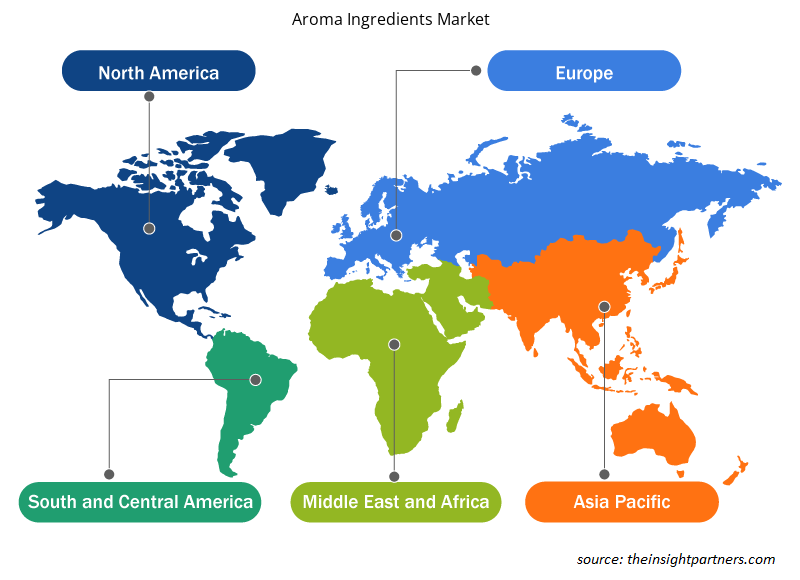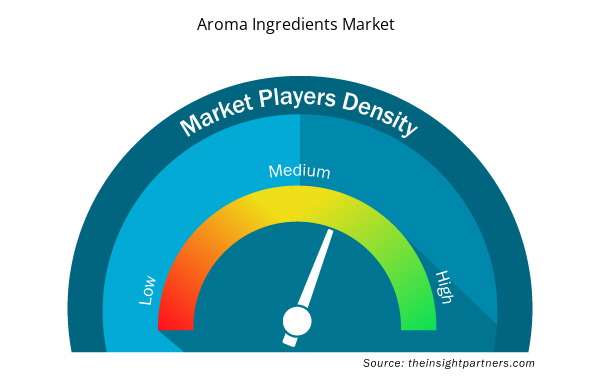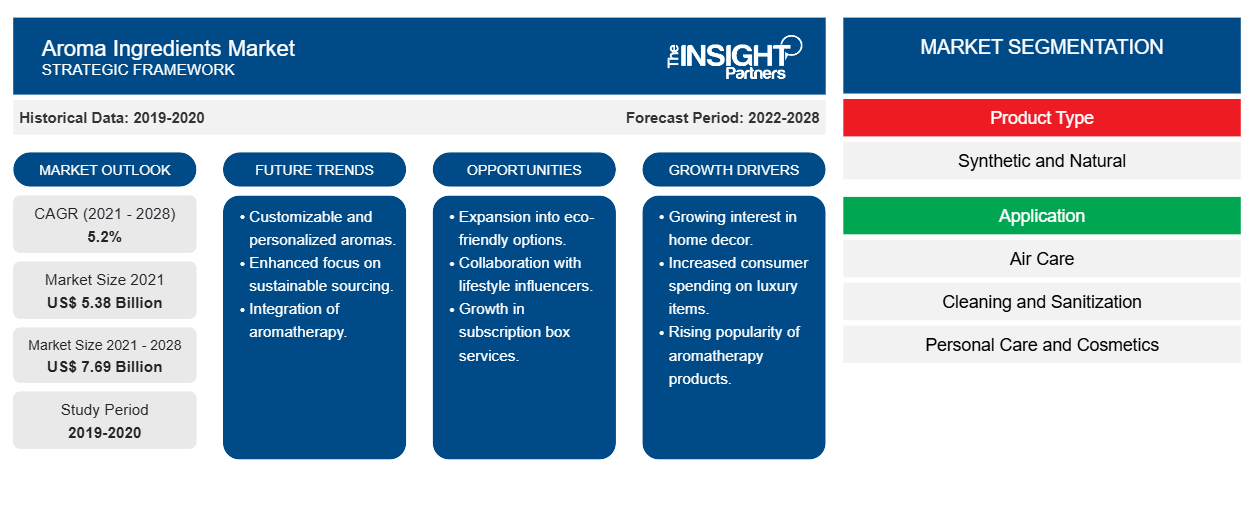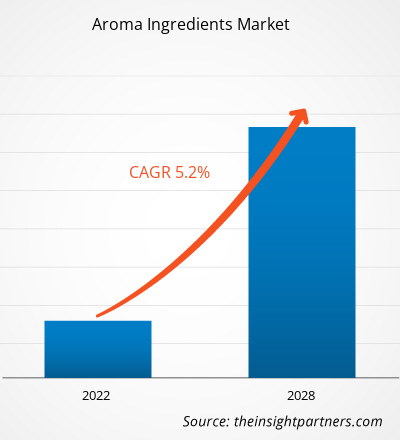Der Markt für Aromabestandteile wurde im Jahr 2021 auf 5.376,90 Millionen US-Dollar geschätzt und soll bis 2028 7.692,62 Millionen US-Dollar erreichen; es wird erwartet, dass er von 2021 bis 2028 mit einer durchschnittlichen jährlichen Wachstumsrate von 5,2 % wächst.
Aromastoffe sind im Grunde komplexe Verbindungen, die Kosmetika, Körperpflegeprodukten sowie Haushaltspflegeprodukten und anderen Produkten zugesetzt werden, um ihnen den gewünschten Duft zu verleihen. Die Aromastoffe können natürlich oder synthetisch sein. Zu den Aromastoffen zählen unter anderem ätherische Öle, Duftstoffe, Isolate, Oleoresine, Absolues, Aromachemikalien und spezielle Aromastoffe. Die sich wandelnde Körperpflege- und Kosmetikbranche hat dem Markt für Aromastoffe zahlreiche neue Wachstumschancen eröffnet und wird den Markt im Prognosezeitraum voraussichtlich ankurbeln.
Im Jahr 2020 dominierte der asiatisch-pazifische Raum den globalen Markt für Aromastoffe und wird seine Dominanz im Prognosezeitraum voraussichtlich beibehalten. In den letzten Jahren ist das Bewusstsein der Menschen im asiatisch-pazifischen Raum für ihr persönliches Erscheinungsbild gestiegen, was zu einer steigenden Nachfrage nach Kosmetikprodukten geführt hat, was wiederum zu einem Wachstum des Kosmetikmarktes in der Region geführt hat. Der Wunsch der asiatischen Verbraucher nach einem vorzeigbaren persönlichen Image hat zu einem erhöhten Bewusstsein für persönliche Hygienegewohnheiten geführt. Die wachsende Sorge der Verbraucher um ihre Gesundheit und Hygiene hat zu einer erhöhten Nachfrage nach Körperpflege-, Kosmetik- sowie Reinigungs- und Desinfektionsprodukten mit Duft- oder Aromastoffen geführt, was wiederum zu einer erhöhten Nachfrage nach Aromastoffen geführt hat. Darüber hinaus besteht der asiatisch-pazifische Raum aus Ländern wie Indien und China, die sich zu Produktionszentren für zahlreiche Endverbrauchsmärkte entwickelt haben, die Aromastoffe verwenden. Die wachsende Bevölkerung in den Entwicklungsländern des asiatisch-pazifischen Raums sowie das steigende verfügbare Einkommen haben zu einer erhöhten Nachfrage nach Körperpflege- und Kosmetikprodukten geführt. Die Nachfrage hat zu einer höheren Inlandsproduktion von Körperpflegeprodukten geführt, was zu einem erhöhten Verbrauch von Aromastoffen in der Region geführt hat.
Passen Sie diesen Bericht Ihren Anforderungen an
Sie erhalten kostenlos individuelle Anpassungen an jedem Bericht, einschließlich Teilen dieses Berichts oder einer Analyse auf Länderebene, eines Excel-Datenpakets sowie tolle Angebote und Rabatte für Start-ups und Universitäten.
- Holen Sie sich die wichtigsten Markttrends aus diesem Bericht.Dieses KOSTENLOSE Beispiel umfasst eine Datenanalyse von Markttrends bis hin zu Schätzungen und Prognosen.
Markteinblicke
Vielfältige Anwendungsmöglichkeiten des Aromastoffs
Die zunehmende Verwendung von Aromastoffen in verschiedenen Anwendungen wie Luftpflege, feinen Düften und Parfüms, Haushaltsprodukten, Lebensmitteln und Getränken sowie Pharmazeutika führt zu einer erhöhten Nachfrage nach Aromastoffen. Feine Düfte umfassen wichtige Anwendungsbereiche wie Parfüms, Eau de Cologne, Körpersprays und Deodorants. Aromastoffe sind eines der wesentlichen Elemente, die in Formulierungen feiner Düfte verwendet werden. Darüber hinaus werden Aromastoffe in Haushaltsprodukten wie Reinigungsmitteln, Hand- und Geschirrspülmitteln, Wäschepflege- und Weichspülern, Tüchern und wässrigen Farbstoffen verwendet. Daher wird eine zunehmende Verwendung von Aromastoffen das Wachstum des Marktes für Aromastoffe vorantreiben.dishwashing liquids, laundry care and fabric softeners,
Einblicke in Produkttypen
Basierend auf dem Produkttyp ist der Markt für Aromastoffe in natürliche und synthetische unterteilt. Im Jahr 2020 war das natürliche Segment das am schnellsten wachsende Segment auf dem Markt für Aromastoffe. Die zunehmenden gesundheitlichen Bedenken im Zusammenhang mit synthetischen Chemikalien haben zu einer erhöhten Nachfrage der Verbraucher nach natürlichen Aromastoffen geführt. Die synthetischen Aromastoffe sind jedoch vergleichsweise einfacher in großem Maßstab herzustellen und behalten dabei über alle Chargen hinweg die gleiche Qualität bei. Die gleichbleibende Qualität synthetischer Inhaltsstoffe hat daher aufgrund der weit verbreiteten Verwendung insbesondere in der schnelllebigen Konsumgüterindustrie zu einem größeren Marktanteil geführt.
Takasago International Corporation; BASF SE; Firmenich SA; Givaudan SA; International Flavors & Fragrances Inc.; Robertet Group; Symrise; Mane; Zhejiang NHU Co., Ltd.; und Phoenix Aromas & Essential Oils, LLC; gehören zu den wichtigsten Akteuren auf dem Markt für Aromastoffe. Die führenden Akteure verfolgen verschiedene Strategien, wie Fusionen und Übernahmen sowie Produkteinführungen, um ihre geografische Präsenz und Kundenbasis zu erweitern. International Corporation; BASF SE; Firmenich S.A.; Givaudan S.A.; International Flavors & Fragrances Inc.; Robertet Group; Symrise; Mane; Zhejiang NHU Co., Ltd.; and Phoenix Aromas & Essential Oils, LLC; are among the key players operating in the aroma ingredients market. The leading players adopt several strategies, such as mergers & acquisitions and product launches, to expand their geographic presence and consumer base.
Regionale Einblicke in den Markt für Aromazutaten
Die regionalen Trends und Faktoren, die den Markt für Aromastoffe im Prognosezeitraum beeinflussen, wurden von den Analysten von Insight Partners ausführlich erläutert. In diesem Abschnitt werden auch die Marktsegmente und die Geografie von Aromastoffen in Nordamerika, Europa, im asiatisch-pazifischen Raum, im Nahen Osten und Afrika sowie in Süd- und Mittelamerika erörtert.

- Erhalten Sie regionale Daten zum Markt für Aromazutaten
Umfang des Marktberichts zu Aromazutaten
| Berichtsattribut | Details |
|---|---|
| Marktgröße im Jahr 2021 | 5,38 Milliarden US-Dollar |
| Marktgröße bis 2028 | 7,69 Milliarden US-Dollar |
| Globale CAGR (2021 - 2028) | 5,2 % |
| Historische Daten | 2019-2020 |
| Prognosezeitraum | 2022–2028 |
| Abgedeckte Segmente | Nach Produkttyp
|
| Abgedeckte Regionen und Länder | Nordamerika
|
| Marktführer und wichtige Unternehmensprofile |
|
Dichte der Marktteilnehmer für Aromazutaten: Die Auswirkungen auf die Geschäftsdynamik verstehen
Der Markt für Aromazutaten wächst rasant, angetrieben durch die steigende Nachfrage der Endverbraucher aufgrund von Faktoren wie sich entwickelnden Verbraucherpräferenzen, technologischen Fortschritten und einem größeren Bewusstsein für die Vorteile des Produkts. Mit steigender Nachfrage erweitern Unternehmen ihr Angebot, entwickeln Innovationen, um die Bedürfnisse der Verbraucher zu erfüllen, und nutzen neue Trends, was das Marktwachstum weiter ankurbelt.
Die Marktteilnehmerdichte bezieht sich auf die Verteilung von Firmen oder Unternehmen, die in einem bestimmten Markt oder einer bestimmten Branche tätig sind. Sie gibt an, wie viele Wettbewerber (Marktteilnehmer) in einem bestimmten Marktraum im Verhältnis zu seiner Größe oder seinem gesamten Marktwert präsent sind.
Die wichtigsten auf dem Markt für Aromastoffe tätigen Unternehmen sind:
- Takasago International Corporation
- BASF SE
- Firmenich SA
- Givaudan SA
- International Flavors & Fragrances Inc.
Haftungsausschluss : Die oben aufgeführten Unternehmen sind nicht in einer bestimmten Reihenfolge aufgeführt.

- Überblick über die wichtigsten Akteure auf dem Markt für Aromazutaten
Bericht-Spotlights
- Progressive Trends in der Aromastoffindustrie helfen den Akteuren bei der Entwicklung wirksamer langfristiger Strategien
- Von Unternehmen verfolgte Geschäftswachstumsstrategien zur Sicherung des Wachstums in entwickelten und sich entwickelnden Märkten
- Quantitative Analyse des globalen Marktes für Aromastoffe von 2019 bis 2028
- Schätzung der Nachfrage nach Aromastoffen in verschiedenen Branchen
- Porters Analyse zur Veranschaulichung der Wirksamkeit von in der Branche tätigen Käufern und Lieferanten bei der Vorhersage des Marktwachstums
- Aktuelle Entwicklungen zum Verständnis der Wettbewerbssituation auf dem Markt und der Nachfrage nach Aromastoffen
- Markttrends und -aussichten in Verbindung mit Faktoren, die das Wachstum des Marktes für Aromazutaten vorantreiben und bremsen
- Verständnis für die Strategien, die dem kommerziellen Interesse im Hinblick auf das Wachstum des globalen Marktes für Aromazutaten zugrunde liegen, und Unterstützung des Entscheidungsprozesses
- Marktgröße für Aromastoffe an verschiedenen Marktknoten
- Detaillierte Übersicht und Segmentierung des globalen Marktes für Aromastoffe sowie seiner Branchendynamik
- Marktgröße für Aromazutaten in verschiedenen Regionen mit vielversprechenden Wachstumschancen
Die „Globale Marktanalyse für Aromastoffe bis 2028“ ist eine spezialisierte und eingehende Studie der Chemie- und Materialindustrie mit besonderem Schwerpunkt auf der globalen Trendanalyse des Marktes für Aromastoffe. Der Bericht soll einen Überblick über den Markt mit detaillierter Marktsegmentierung bieten. Der Markt für Aromastoffe ist nach Produkttyp, Anwendung und Geografie segmentiert. Basierend auf dem Produkttyp ist der Markt in natürliche und synthetische Produkte segmentiert. Basierend auf der Anwendung ist der Markt in Luftpflege, Reinigung und Desinfektion, Körperpflege und Kosmetik, feine Düfte und Parfüms und andere segmentiert. Basierend auf der Geografie ist der Markt in fünf Hauptregionen segmentiert – Nordamerika, Europa, Asien-Pazifik, Naher Osten und Afrika sowie Süd- und Mittelamerika.
Firmenprofile
- Takasago International Corporation
- BASF SE
- Firmenich SA
- Givaudan SA
- International Flavors & Fragrances Inc.
- Robertet-Gruppe
- Symrise
- Mähne
- Zhejiang NHU Co., Ltd.
- Phoenix Aromas & Essential Oils, LLC.
- Historische Analyse (2 Jahre), Basisjahr, Prognose (7 Jahre) mit CAGR
- PEST- und SWOT-Analyse
- Marktgröße Wert/Volumen – Global, Regional, Land
- Branche und Wettbewerbsumfeld
- Excel-Datensatz



Report Coverage
Revenue forecast, Company Analysis, Industry landscape, Growth factors, and Trends

Segment Covered
This text is related
to segments covered.

Regional Scope
North America, Europe, Asia Pacific, Middle East & Africa, South & Central America

Country Scope
This text is related
to country scope.
Häufig gestellte Fragen
Aroma ingredients are extensively used to create a wide range of fragrances. Increased healthcare awareness and disposable income have increased demand for consumer goods such as soaps, hand wash, sanitizers, detergents and toiletries. Although, the expansion of the personal care and household care industries significantly contributes to the growth of the aroma ingredient market. Manufacturers focus on increasing natural ingredients for the flavor and fragrance industry to ensure the sustainable sourcing of raw materials.
In 2020, the natural segment accounted for the fastest-growing segment. Natural aroma ingredients are extracted from natural sources, including wood, spices, flowers, and fruits. The rising awareness of the negative effects of synthetic ingredients on human health has increased the demand for natural and bio-based aroma ingredients.
Based on application, personal care and cosmetics are the fastest-growing segments. Aroma ingredients are extensively used in manufacturing personal care and cosmetics products. Continuous technological developments in the personal care and cosmetics sectors and innovations and research and development expenditures are expected to propel the growth of the aroma ingredient market.
In 2020, the synthetic segment accounted for the largest market share. Synthetic aroma ingredients can reproduce a natural and robust scent without compromising the fragrance to manufacture quality fragrance. It has strong demand in manufacturing soaps, shampoos, body lotions, hair conditioners, and other cosmetic and personal care products.
The major players operating in the global metakaolin market are Takasago International Corporation, BASF SE, Firmenich S.A., Givaudan S.A., International Flavors & Fragrances Inc., Robertet Group, Symrise, Mane, Zhejiang NHU Co., Ltd., and Phoenix Aromas & Essential Oils, LLC.
In 2020, Asia Pacific accounted for the largest share of the global aroma ingredient market. The aroma ingredient industry is anticipated to expand faster due to increasing awareness of personal care and hygiene.
Trends and growth analysis reports related to Chemicals and Materials : READ MORE..
The List of Companies - Aroma Ingredient Market
- Takasago International Corporation
- BASF SE
- Firmenich S.A.
- Givaudan S.A.
- International Flavors & Fragrances Inc.
- Robertet Group
- Symrise
- Mane
- Zhejiang NHU Co., Ltd.
- Phoenix Aromas & Essential Oils, LLC.
The Insight Partners performs research in 4 major stages: Data Collection & Secondary Research, Primary Research, Data Analysis and Data Triangulation & Final Review.
- Data Collection and Secondary Research:
As a market research and consulting firm operating from a decade, we have published and advised several client across the globe. First step for any study will start with an assessment of currently available data and insights from existing reports. Further, historical and current market information is collected from Investor Presentations, Annual Reports, SEC Filings, etc., and other information related to company’s performance and market positioning are gathered from Paid Databases (Factiva, Hoovers, and Reuters) and various other publications available in public domain.
Several associations trade associates, technical forums, institutes, societies and organization are accessed to gain technical as well as market related insights through their publications such as research papers, blogs and press releases related to the studies are referred to get cues about the market. Further, white papers, journals, magazines, and other news articles published in last 3 years are scrutinized and analyzed to understand the current market trends.
- Primary Research:
The primarily interview analysis comprise of data obtained from industry participants interview and answers to survey questions gathered by in-house primary team.
For primary research, interviews are conducted with industry experts/CEOs/Marketing Managers/VPs/Subject Matter Experts from both demand and supply side to get a 360-degree view of the market. The primary team conducts several interviews based on the complexity of the markets to understand the various market trends and dynamics which makes research more credible and precise.
A typical research interview fulfils the following functions:
- Provides first-hand information on the market size, market trends, growth trends, competitive landscape, and outlook
- Validates and strengthens in-house secondary research findings
- Develops the analysis team’s expertise and market understanding
Primary research involves email interactions and telephone interviews for each market, category, segment, and sub-segment across geographies. The participants who typically take part in such a process include, but are not limited to:
- Industry participants: VPs, business development managers, market intelligence managers and national sales managers
- Outside experts: Valuation experts, research analysts and key opinion leaders specializing in the electronics and semiconductor industry.
Below is the breakup of our primary respondents by company, designation, and region:

Once we receive the confirmation from primary research sources or primary respondents, we finalize the base year market estimation and forecast the data as per the macroeconomic and microeconomic factors assessed during data collection.
- Data Analysis:
Once data is validated through both secondary as well as primary respondents, we finalize the market estimations by hypothesis formulation and factor analysis at regional and country level.
- Macro-Economic Factor Analysis:
We analyse macroeconomic indicators such the gross domestic product (GDP), increase in the demand for goods and services across industries, technological advancement, regional economic growth, governmental policies, the influence of COVID-19, PEST analysis, and other aspects. This analysis aids in setting benchmarks for various nations/regions and approximating market splits. Additionally, the general trend of the aforementioned components aid in determining the market's development possibilities.
- Country Level Data:
Various factors that are especially aligned to the country are taken into account to determine the market size for a certain area and country, including the presence of vendors, such as headquarters and offices, the country's GDP, demand patterns, and industry growth. To comprehend the market dynamics for the nation, a number of growth variables, inhibitors, application areas, and current market trends are researched. The aforementioned elements aid in determining the country's overall market's growth potential.
- Company Profile:
The “Table of Contents” is formulated by listing and analyzing more than 25 - 30 companies operating in the market ecosystem across geographies. However, we profile only 10 companies as a standard practice in our syndicate reports. These 10 companies comprise leading, emerging, and regional players. Nonetheless, our analysis is not restricted to the 10 listed companies, we also analyze other companies present in the market to develop a holistic view and understand the prevailing trends. The “Company Profiles” section in the report covers key facts, business description, products & services, financial information, SWOT analysis, and key developments. The financial information presented is extracted from the annual reports and official documents of the publicly listed companies. Upon collecting the information for the sections of respective companies, we verify them via various primary sources and then compile the data in respective company profiles. The company level information helps us in deriving the base number as well as in forecasting the market size.
- Developing Base Number:
Aggregation of sales statistics (2020-2022) and macro-economic factor, and other secondary and primary research insights are utilized to arrive at base number and related market shares for 2022. The data gaps are identified in this step and relevant market data is analyzed, collected from paid primary interviews or databases. On finalizing the base year market size, forecasts are developed on the basis of macro-economic, industry and market growth factors and company level analysis.
- Data Triangulation and Final Review:
The market findings and base year market size calculations are validated from supply as well as demand side. Demand side validations are based on macro-economic factor analysis and benchmarks for respective regions and countries. In case of supply side validations, revenues of major companies are estimated (in case not available) based on industry benchmark, approximate number of employees, product portfolio, and primary interviews revenues are gathered. Further revenue from target product/service segment is assessed to avoid overshooting of market statistics. In case of heavy deviations between supply and demand side values, all thes steps are repeated to achieve synchronization.
We follow an iterative model, wherein we share our research findings with Subject Matter Experts (SME’s) and Key Opinion Leaders (KOLs) until consensus view of the market is not formulated – this model negates any drastic deviation in the opinions of experts. Only validated and universally acceptable research findings are quoted in our reports.
We have important check points that we use to validate our research findings – which we call – data triangulation, where we validate the information, we generate from secondary sources with primary interviews and then we re-validate with our internal data bases and Subject matter experts. This comprehensive model enables us to deliver high quality, reliable data in shortest possible time.


 Holen Sie sich ein kostenloses Muster für diesen Bericht
Holen Sie sich ein kostenloses Muster für diesen Bericht